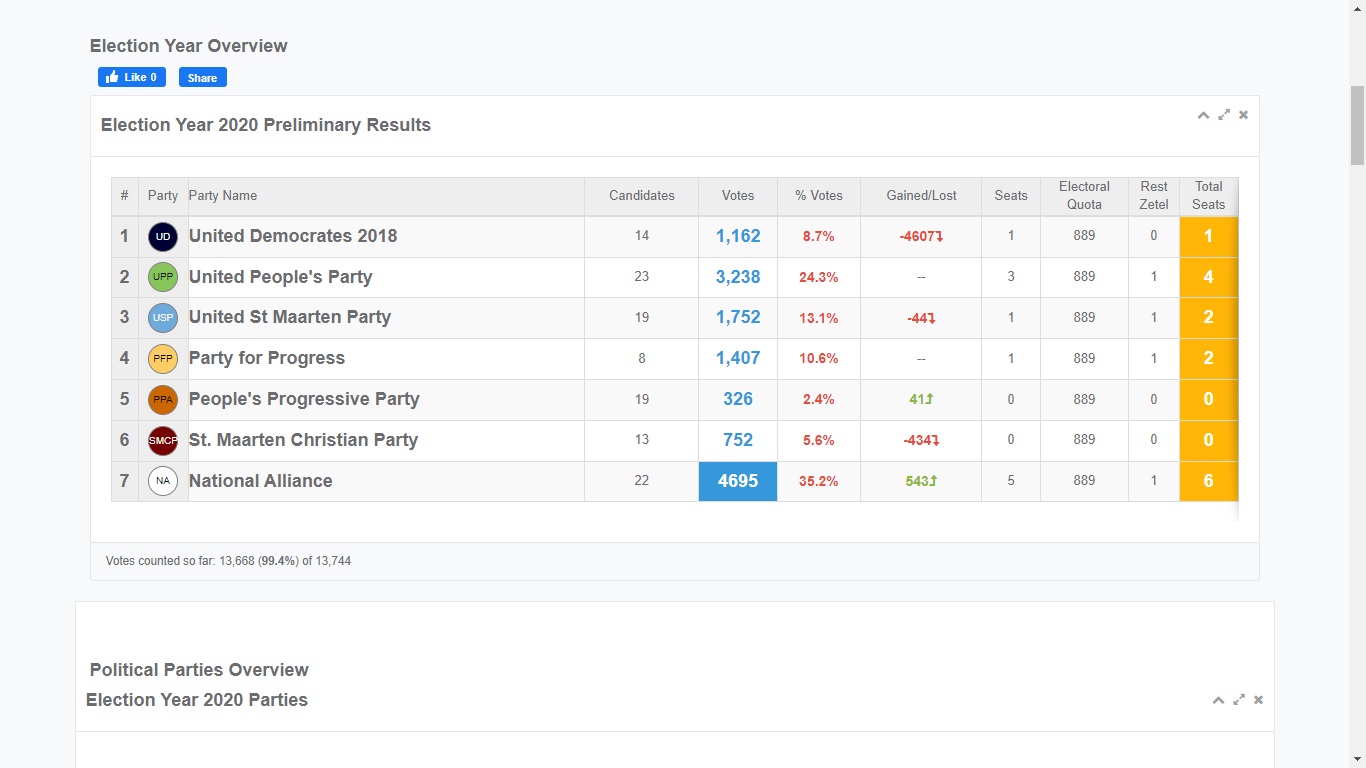It pays to go into elections with the maximum number of candidates
PHILIPSBURG — It is worthwhile to enter elections with a full list of 23 candidates. This appears from our analysis of the 2020-elections. Generally, the top five vote getters on a list are good for around 65 percent of the votes, but the remaining 35 percent can still make a big difference.
Take for instance the United People’s party (UP). In 2020 the party won 3,238 votes and the top five candidates were good for 2,119 votes or 65.4 percent. The remaining 34.6 percent however, represented a massive 1,119 votes – and these are all votes bought home by candidates who will never get near a seat in Parliament.
The 65-35 split between the five biggest vote getters and the rest also applies to the United St. Maarten party (USp). The party won 1,752 votes and the top five scored 1,108 of them (63.2 percent). Unlike the UP, the USp fielded just 19 candidates and the other fourteen won just 644 votes between them.
The fewer candidates that are on a list, the less support the party may expect from these candidates in terms of voter-support. Look at the Party for Progress that went to war with only eight candidates. The party won nevertheless 1,407 votes of which 1,232 went to the top five (87.6 percent). The remaining candidates won just 175 votes between them.
A similar picture emerges from the results of the St. Maarten Christian Party (SMCP). It won 752 votes, 577 (76.7 percent) went to the top five and the other eight candidates brought in just 175 votes.
With Gracita Arrindell’s Progressive People’s Alliance (PPA) it was the same story. Of the disappointing 326 votes the party won, 228 went to the top five (69.9 percent) while the remaining ten candidates won only 98 votes.
The National Alliance went into the 2020 elections with a full slate of 23 candidates and it paid off. The party won 4,695 votes of which 3,018 (64.3 percent) went to the top five and a massive 1,677 (35.7 percent) to the other eighteen candidates.
The lists of candidates presented by the National Alliance stands out from the rest, because twelve candidates won more than one hundred votes. The UP had nine candidates and the USp six with such a result. The PFP had five out of 8 candidates with more than one hundred votes.
The dynamics for the upcoming elections have changed dramatically, especially for the UP because Grisha Heyliger-Marten (656 votes in 2020), Ludmila de Weever (267), Luc Mercelina (248) and Kevin Maingrette (148) have all left the party. De Weever, in her short political career over the past four years, went from being a member of parliament to being a minister (of TEATT), back to parliament as MP, left the UPP and went independent, to now joining PFP. Mercelina has started his own party (URSM) and Maingrette has joined Christophe Emmanuel’s NOW party. Heyliger-Marten has joined forces with MP Sarah Wescot-Williams in a revived Democratic Party. According to sources close to the party, the DP will be running with a full slate of candidates. Despite the recent loss of Shirley Hilaire, the party boasts candidates such as Benjamin Bell and Viren Kotai, both former SMCP candidates, Khalil Revan (ex-USp), and a heavy weight lawyer and a well-known environmentalist. Despite adding Hilaire to its roster of candidates, the UP will have to compensate for the potential loss of 1,319 votes with other candidates and that is a tall order as the party seems to be imploding on itself with the recent exodus of candidates such as Melisa Molanus who has now joined the NA party. The UP’s new star-member Mark Mingo remains a dark horse, but he may be just what the party needs to remain significant in the local political landscape.
The true vote-getting potential of each party will only become clear after the publication of the lists of candidates.
###
Read our Editorial entitled “Analysis: Electoral Strategies and the Significance of a Full Slate“



























